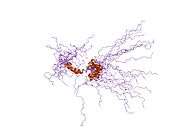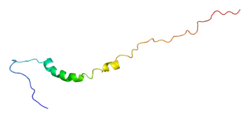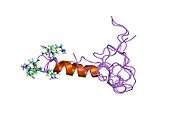KCNA4
| Potassium channel Kv1.4 tandem inactivation domain | |||||||||
|---|---|---|---|---|---|---|---|---|---|
 solution structure of the tandem inactivation domain (residues 1-75) of potassium channel rck4 (kv1.4) | |||||||||
| Identifiers | |||||||||
| Symbol | K_channel_TID | ||||||||
| Pfam | PF07941 | ||||||||
| InterPro | IPR012897 | ||||||||
| SCOP | 1kn7 | ||||||||
| SUPERFAMILY | 1kn7 | ||||||||
| |||||||||
Potassium voltage-gated channel subfamily A member 4 also known as Kv1.4 is a protein that in humans is encoded by the KCNA4 gene.[5][6][7] It contributes to the cardiac transient outward potassium current (Ito1), the main contributing current to the repolarizing phase 1 of the cardiac action potential.[8]
Description
Potassium channels represent the most complex class of voltage-gated ion channels from both functional and structural standpoints. Their diverse functions include regulating neurotransmitter release, heart rate, insulin secretion, neuronal excitability, epithelial electrolyte transport, smooth muscle contraction, and cell volume. Four sequence-related potassium channel genes - shaker, shaw, shab, and shal - have been identified in Drosophila, and each has been shown to have human homolog(s). This gene encodes a member of the potassium channel, voltage-gated, shaker-related subfamily. This member contains six membrane-spanning domains with a shaker-type repeat in the fourth segment. It belongs to the A-type potassium current class, the members of which may be important in the regulation of the fast repolarizing phase of action potentials in heart and thus may influence the duration of cardiac action potential. The coding region of this gene is intronless, and the gene is clustered with genes KCNA3 and KCNA10 on chromosome 1 in humans.[7]
KCNA4 (Kv1.4) contains a tandem inactivation domain at the N terminus. It is composed of two subdomains. Inactivation domain 1 (ID1, residues 1-38) consists of a flexible N terminus anchored at a 5-turn helix, and is thought to work by occluding the ion pathway, as is the case with a classical ball domain. Inactivation domain 2 (ID2, residues 40-50) is a 2.5 turn helix with a high proportion of hydrophobic residues that probably serves to attach ID1 to the cytoplasmic face of the channel. In this way, it can promote rapid access of ID1 to the receptor site in the open channel. ID1 and ID2 function together to bring about fast inactivation of the Kv1.4 channel, which is important for the role of the channel in short-term plasticity.[9]
Interactions
KCNA4 has been shown to interact with DLG4,[10][11][12][13] KCNA2[14] and DLG1.[10][12][15]
See also
References
- 1 2 3 GRCh38: Ensembl release 89: ENSG00000182255 - Ensembl, May 2017
- 1 2 3 GRCm38: Ensembl release 89: ENSMUSG00000042604 - Ensembl, May 2017
- ↑ "Human PubMed Reference:".
- ↑ "Mouse PubMed Reference:".
- ↑ Philipson LH, Schaefer K, LaMendola J, Bell GI, Steiner DF (Feb 1991). "Sequence of a human fetal skeletal muscle potassium channel cDNA related to RCK4". Nucleic Acids Res. 18 (23): 7160. doi:10.1093/nar/18.23.7160. PMC 332806. PMID 2263489.
- ↑ Gutman GA, Chandy KG, Grissmer S, Lazdunski M, McKinnon D, Pardo LA, Robertson GA, Rudy B, Sanguinetti MC, Stuhmer W, Wang X (Dec 2005). "International Union of Pharmacology. LIII. Nomenclature and molecular relationships of voltage-gated potassium channels". Pharmacol Rev. 57 (4): 473–508. doi:10.1124/pr.57.4.10. PMID 16382104.
- 1 2 "Entrez Gene: KCNA4 potassium voltage-gated channel, shaker-related subfamily, member 4".
- ↑ Oudit GY, Kassiri Z, Sah R, Ramirez RJ, Zobel C, Backx PH (May 2001). "The molecular physiology of the cardiac transient outward potassium current (I(to)) in normal and diseased myocardium". J. Mol. Cell. Cardiol. 33 (5): 851–72. doi:10.1006/jmcc.2001.1376. PMID 11343410.
- ↑ Wissmann R, Bildl W, Oliver D, Beyermann M, Kalbitzer HR, Bentrop D, Fakler B (May 2003). "Solution structure and function of the "tandem inactivation domain" of the neuronal A-type potassium channel Kv1.4". J. Biol. Chem. 278 (18): 16142–50. doi:10.1074/jbc.M210191200. PMID 12590144.
- 1 2 Inanobe, Atsushi; Fujita Akikazu; Ito Minoru; Tomoike Hitonobu; Inageda Kiyoshi; Kurachi Yoshihisa (Jun 2002). "Inward rectifier K+ channel Kir2.3 is localized at the postsynaptic membrane of excitatory synapses". Am. J. Physiol., Cell Physiol. United States. 282 (6): C1396–403. doi:10.1152/ajpcell.00615.2001. ISSN 0363-6143. PMID 11997254.
- ↑ Niethammer, M; Valtschanoff J G; Kapoor T M; Allison D W; Weinberg R J; Craig A M; Sheng M (Apr 1998). "CRIPT, a novel postsynaptic protein that binds to the third PDZ domain of PSD-95/SAP90". Neuron. UNITED STATES. 20 (4): 693–707. doi:10.1016/S0896-6273(00)81009-0. ISSN 0896-6273. PMID 9581762.
- 1 2 Kim, E; Sheng M (1996). "Differential K+ channel clustering activity of PSD-95 and SAP97, two related membrane-associated putative guanylate kinases". Neuropharmacology. ENGLAND. 35 (7): 993–1000. doi:10.1016/0028-3908(96)00093-7. ISSN 0028-3908. PMID 8938729.
- ↑ Eldstrom, Jodene; Doerksen Kyle W; Steele David F; Fedida David (Nov 2002). "N-terminal PDZ-binding domain in Kv1 potassium channels". FEBS Lett. Netherlands. 531 (3): 529–37. doi:10.1016/S0014-5793(02)03572-X. ISSN 0014-5793. PMID 12435606.
- ↑ Coleman, S K; Newcombe J; Pryke J; Dolly J O (Aug 1999). "Subunit composition of Kv1 channels in human CNS". J. Neurochem. UNITED STATES. 73 (2): 849–58. doi:10.1046/j.1471-4159.1999.0730849.x. ISSN 0022-3042. PMID 10428084.
- ↑ Eldstrom, Jodene; Choi Woo Sung; Steele David F; Fedida David (Jul 2003). "SAP97 increases Kv1.5 currents through an indirect N-terminal mechanism". FEBS Lett. Netherlands. 547 (1–3): 205–11. doi:10.1016/S0014-5793(03)00668-9. ISSN 0014-5793. PMID 12860415.
Further reading
- Scott HS, Litjens T, Hopwood JJ, Morris CP (1993). "PCR detection of two RFLPs in exon I of the alpha-L-iduronidase (IDUA) gene". Hum. Genet. 90 (3): 327. doi:10.1007/bf00220095. PMID 1362562.
- Gessler M, Grupe A, Grzeschik KH, Pongs O (1993). "The potassium channel gene HK1 maps to human chromosome 11p14.1, close to the FSHB gene". Hum. Genet. 90 (3): 319–21. doi:10.1007/bf00220091. PMID 1487251.
- Philipson LH, Hice RE, Schaefer K, et al. (1991). "Sequence and functional expression in Xenopus oocytes of a human insulinoma and islet potassium channel". Proc. Natl. Acad. Sci. U.S.A. 88 (1): 53–7. Bibcode:1991PNAS...88...53P. doi:10.1073/pnas.88.1.53. PMC 50746. PMID 1986382.
- Tamkun MM, Knoth KM, Walbridge JA, et al. (1991). "Molecular cloning and characterization of two voltage-gated K+ channel cDNAs from human ventricle". FASEB J. 5 (3): 331–7. PMID 2001794.
- Kim E, Niethammer M, Rothschild A, et al. (1995). "Clustering of Shaker-type K+ channels by interaction with a family of membrane-associated guanylate kinases". Nature. 378 (6552): 85–8. Bibcode:1995Natur.378...85K. doi:10.1038/378085a0. PMID 7477295.
- Klocke R, Roberds SL, Tamkun MM, et al. (1994). "Chromosomal mapping in the mouse of eight K(+)-channel genes representing the four Shaker-like subfamilies Shaker, Shab, Shaw, and Shal". Genomics. 18 (3): 568–74. doi:10.1016/S0888-7543(05)80358-1. PMID 7905852.
- Philipson LH, Eddy RL, Shows TB, Bell GI (1993). "Assignment of human potassium channel gene KCNA4 (Kv1.4, PCN2) to chromosome 11q13.4→q14.1". Genomics. 15 (2): 463–4. doi:10.1006/geno.1993.1094. PMID 8449523.
- Niethammer M, Kim E, Sheng M (1996). "Interaction between the C terminus of NMDA receptor subunits and multiple members of the PSD-95 family of membrane-associated guanylate kinases". J. Neurosci. 16 (7): 2157–63. PMID 8601796.
- Kim E, Sheng M (1997). "Differential K+ channel clustering activity of PSD-95 and SAP97, two related membrane-associated putative guanylate kinases". Neuropharmacology. 35 (7): 993–1000. doi:10.1016/0028-3908(96)00093-7. PMID 8938729.
- Kim E, Naisbitt S, Hsueh YP, et al. (1997). "GKAP, a novel synaptic protein that interacts with the guanylate kinase-like domain of the PSD-95/SAP90 family of channel clustering molecules". J. Cell Biol. 136 (3): 669–78. doi:10.1083/jcb.136.3.669. PMC 2134290. PMID 9024696.
- Niethammer M, Valtschanoff JG, Kapoor TM, et al. (1998). "CRIPT, a novel postsynaptic protein that binds to the third PDZ domain of PSD-95/SAP90". Neuron. 20 (4): 693–707. doi:10.1016/S0896-6273(00)81009-0. PMID 9581762.
- Brenman JE, Topinka JR, Cooper EC, et al. (1998). "Localization of postsynaptic density-93 to dendritic microtubules and interaction with microtubule-associated protein 1A". J. Neurosci. 18 (21): 8805–13. PMID 9786987.
- Coleman SK, Newcombe J, Pryke J, Dolly JO (1999). "Subunit composition of Kv1 channels in human CNS". J. Neurochem. 73 (2): 849–58. doi:10.1046/j.1471-4159.1999.0730849.x. PMID 10428084.
- D'Adamo MC, Imbrici P, Sponcichetti F, Pessia M (1999). "Mutations in the KCNA1 gene associated with episodic ataxia type-1 syndrome impair heteromeric voltage-gated K(+) channel function". FASEB J. 13 (11): 1335–45. PMID 10428758.
- Hogan A, Shepherd L, Chabot J, et al. (2001). "Interaction of gamma 1-syntrophin with diacylglycerol kinase-zeta. Regulation of nuclear localization by PDZ interactions". J. Biol. Chem. 276 (28): 26526–33. doi:10.1074/jbc.M104156200. PMID 11352924.
- Cukovic D, Lu GW, Wible B, et al. (2001). "A discrete amino terminal domain of Kv1.5 and Kv1.4 potassium channels interacts with the spectrin repeats of alpha-actinin-2". FEBS Lett. 498 (1): 87–92. doi:10.1016/S0014-5793(01)02505-4. PMID 11389904.
- Imamura F, Maeda S, Doi T, Fujiyoshi Y (2002). "Ligand binding of the second PDZ domain regulates clustering of PSD-95 with the Kv1.4 potassium channel". J. Biol. Chem. 277 (5): 3640–6. doi:10.1074/jbc.M106940200. PMID 11723117.
- Piserchio A, Pellegrini M, Mehta S, et al. (2002). "The PDZ1 domain of SAP90. Characterization of structure and binding". J. Biol. Chem. 277 (9): 6967–73. doi:10.1074/jbc.M109453200. PMID 11744724.
External links
- Kv1.4+Potassium+Channel at the US National Library of Medicine Medical Subject Headings (MeSH)
- KCNA4+protein,+human at the US National Library of Medicine Medical Subject Headings (MeSH)
This article incorporates text from the United States National Library of Medicine, which is in the public domain.






